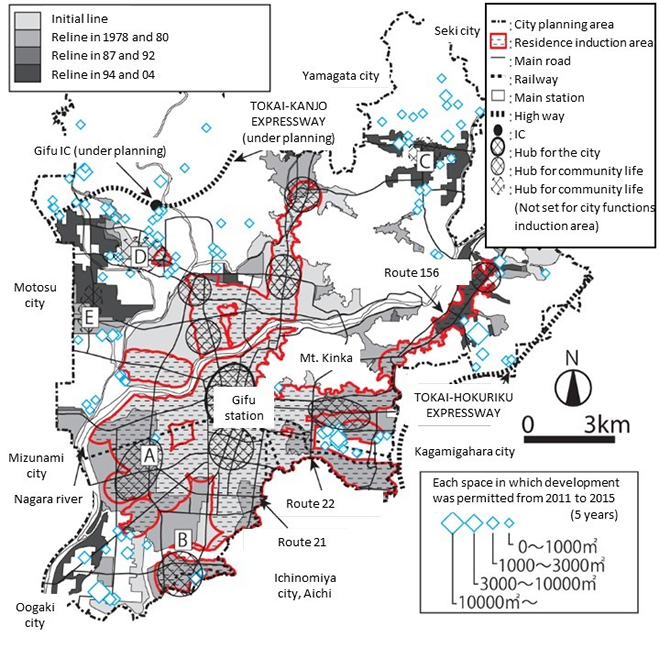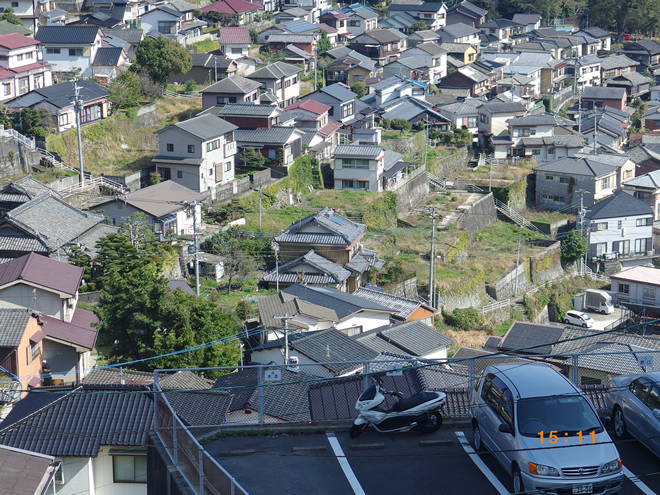
ここからコンテンツです。

The Bright Side of Urban Shrinkage:
Steps toward Restructuring Cities
Junichiro Asano

One urgent challenge resulting from the rapid population decline in Japan today is the problem of urban shrinkage. Professor Junichiro Asano is engaging in this major theme from the viewpoint of a “land utilization plan”: an approach to prevent city dilution; a way to utilize the sprawling empty space and abandoned houses; and a method to maintain or reconstruct the city to be an attractive and comfortable place to live in. As a specialist, he is keen to present the problems after fully understanding the current conditions and tasks, and to encourage people to discuss the newly proposed suggestions.
Interview and report by Madoka Tainaka
Making the current problems clear, taking the role of the City Planning Law into account
In August 2017, The Architectural Institute of Japan published a book entitled “Land utilization plan during the urban shrinkage period: Challenges and approaches to create a diverse urban space.” The leader who coordinated this book project, Professor Junichiro Asano, served as the chief examiner for the “Land Utilization Problems Committee” of this institute for over four years until last year. His research achievements included writing part of the book, and engaging in selecting writers, including international researchers.
Professor Asano explains “the purpose of this book was to lay out the challenges of land utilization plans in full, clarifying the current challenges and identifying problems. In more concrete terms, the book is split into two parts: Symptoms and Solutions; and individual problems occurring in both metropolitan areas and provincial cities are explained in detail.”
The main theme of the book is the land utilization plan system which Professor Asano specializes in: the so-called “dividing system” and “development permission system.” The dividing system is a system classifying urbanization promotion and control areas based on the City Planning Law. The development permission system secures the purposes of this classification. Both systems work for the purpose of healthy urban development, by restricting areas to be developed and promoting planned urbanization.

Professor Asano explains, “These systems were established pursuant to the new City Planning Law, which became effective in 1968, and Japan can rightly be proud of them. Originally, they were made for the purpose of systematically designing urban district development, in preparation for future population increases. However, these systems later also functioned as a major deterrent of suburban sprawl. They are valuable systems and should continue to be maintained in the future for the purpose of environmental protection in rural areas and the promotion of sensible planning for making cities compact. However, various operational issues were discovered following a decrease in population. Pointing out these challenges and suggesting their solutions is one of the objectives of my research.”
Need for a land utilization plan that can adapt to changes over time
So far the City Planning Law has undergone several major amendments in response to the slowing of population growth and the new reality of an aging society. In 2000, a major amendment was made to include deregulation measures, and in 2006, the amended City Planning Law was established, including strict regulation of large scale shopping and leisure centers regarding opening their stores in the suburbs, and expanding the development permission system to include public facilities. These amendments gradually paved the way for introducing city functions and residential areas in accordance with social changes.
However, Professor Asano indicates that today the existing model is facing difficulties of maintaining a healthy city appearance.
“The premise of the conventional basic land utilization plan is beginning to show cracks due to urban shrinkage. If the population density in an area designated for urbanization falls below 40 people per hectare, maintaining the city planning area becomes difficult. Now, some areas designated for urbanization are forced to shrink because of reclassification. Decline in population density in cities will be an inevitable problem in the future, and discussion on the appropriate density is required.”
Due to population decrease, area shrinkage seems necessary for maintaining city functions. However, on the other side of the compact city debate is the fear that the suburbs may be abandoned.
Then, in 2014, the Location Adequacy Plan pursuant to the amended Urban Renaissance Special Measure Law was formulated. “This is an idea of gradually shrinking not only the central business district but also connected areas, by creating multiple cores in suburbs and connecting them to public transportation and other networks. Constructing welfare facilities in the cores allows for the creation of senior friendly towns, and the shrinkage plan will be reviewed every five years in order to align with current circumstances.”

In recent years, various regional revitalization programs were started by means of the “Town, People, and Work Creation Law” to address the overconcentration of the population in the Tokyo area and to improve the appeal of all regions across the country. In 2015, the Special Measures Concerning Unoccupied Housing Act came into effect. These programs show a national intention of giving a soft landing to the urban shrinking problem through establishing new regulations while effectively utilizing the current law systems.
“This national position itself is characteristically Japanese, though that is not necessarily a negative thing. However, the approach of restructuring cities by means of a land utilization plan needs to be discussed in more depth. Moreover, in the future, raising points of discussion regarding the method of designing law systems seems to be part of our roles as specialists.”
What it means to learn from international case studies
Another current interest of Professor Asano is in comparing the situation of Japanese cities to other cities abroad.
Professor Asano said, “In Europe and the US, the problem of urban shrinkage has been discussed in the early stages and researchers are actively engaging in international comparative studies. There are many researchers motivated to learn from case studies in other countries from the viewpoint of preventative resilience, such as recovery and defense strategies, rather than dealing with the problem after it has occurred, as Japan has done.”
However, especially in Europe, the way in which public services are viewed is greatly different from in Japan. City functions, including public transportation, are considered as a public right, so they are neither planned nor operated on a profit basis. Urban areas and other areas are clearly divided and the discussion about unoccupied housing issues is made from the viewpoint of how to fill the “holes” in a city.
“The scattered dilution phenomenon seen in Japan is caused by vague boundary lines between urban areas and other areas, and it is difficult for people in Europe to relate to.”
“Even so, discussion with international researchers is very productive. In Japan, the discussion of urban shrinkage seems to be unbalanced, focusing only on limited themes such as problems regarding increasing sparsity and unoccupied housing in cities. However, international researchers speak freely of reconsidering the Linear Shinkansen, or moving towards an active immigration policy, though such topics would be deemed as taboo in Japan. Actually, it is true that the opening of the Shinkansen increased the overconcentration in Tokyo, and acceptance of immigrants may lead to preventing a decline in the labor population.”
“Individual cultures and regulations are different, though they all face the same problem of urban shrinkage. Listening to opinions from international researchers is very productive.”
Also, Professor Asano says that multiple causes exist for urban shrinkage and that there are different solutions for each cause. As was seen in the dramatic change in towns caused by the Great East Japan Earthquake and the following accident in the nuclear power plant, natural disasters and accidents can cause urban shrinkage. Whereas, as seen in Russia, Ukraine, Romania, and Syria, rapid changes in society and the ravages of war also can cause major changes in town appearance. He says that it is also important to learn from several different types of cases such as these.
“The population decrease is a negative factor; however, we must consider it as an opportunity to improve cities effectively. There is no silver bullet that will fix everything immediately, but even so I am highly motivated to raise points of discussion and provide some advice as a specialist to contribute to further discussion.”
Professor Asano said that seeing changes in towns based on policies incorporating his suggestions is the real pleasure of city research. He also said that he is keen to contribute to city creation while more actively collaborating with international researchers in the future.
Reporter's Note
Professor Asano said that though he has had many opportunities to visit countries in his research, he feels “he likes Japan better” each time he comes back. “In Finland, since the 19th century, cities were designed with modern architecture and the quality of design is very high. The level of education is also high and it has a substantial social security system. There is a relaxed air there. We have many things to learn from Finland, which built such attractive cities with a population of 10 million people.” Moreover, he said that allotment gardens such as “Kolonihave” in Denmark and “Kleingarten” in Germany also give clues on handling urban shrinkage. There are many things to be learned from European countries; not only about city appearance, but also about workstyles and leisure time.
都市縮小をチャンスと捉え、まちを再構築するために
急激な人口減少に伴い、現在の日本で、喫緊の課題とされるのが、都市の縮小問題である。都市の希薄化をいかに防ぎ、無秩序に広がる空き地や空き家をどう活かして、住みやすい、魅力ある都市を保ち、あるいは再生するのか。浅野純一郎教授は、この大テーマに「土地利用計画」の観点から取り組んでいる。専門家として現状や課題を把握、問題を提起し、新たな提案を投げかけることで、人々の議論を促したいという。
都市計画法の役割を踏まえ、現状の問題点を明らかに
2017年8月、日本建築学会が『都市縮小時代の土地利用計画−多様な都市空間創出へ向けた課題と対応策』と題する本を出版した。この本を取りまとめたのは、同学会の「土地利用問題委員会」で昨年まで4年にわたり主査を務めた浅野純一郎教授だ。自ら研究の成果として一部の原稿を執筆するとともに、海外の研究者を含めた著者の選定に携わった。
「本書の目的は、土地利用計画の課題を全面に打ち出し、現状の課題を明らかにして、問題提起をすることにありました。具体的には現象編と解決編の二本立てとし、大都市圏と地方都市、それぞれで起きている問題を切り分けて、ていねいに解説しました」と浅野教授は説明する。
とくに、中心的な話題として取り上げたのが、浅野教授の専門である土地利用計画制度、いわゆる「線引き制度」と「開発許可制度」だ。線引き制度とは、都市計画法に基づき、市街化区域と市街化調整区域を区分する制度のこと。開発許可制度は、その線引きの目的を担保するための制度である。いずれも都市の健全な成長をめざして、整備すべき区域を絞って計画的に市街化を進める役割を担ってきた。
「これらの制度は、1968年に施行された新都市計画法で制定されたもので、日本が誇るべき制度の一つと言えます。本来は将来の人口増加に備えて計画的に市街地整備を図る目的でつくられたものでしたが、その後も、郊外へのスプロール化(無計画な拡大)の抑止力として大きな役割を果たしてきました。今後も田園地域の環境保全やスマートに都市のコンパクト化を進めるうえで、維持されるべき貴重な制度だと思います。ただし、人口減少が進むなか、運用面でいろいろと問題も出てきている。その課題を指摘し、対応策を示すのが、私の研究の目的の一つなのです」と浅野教授は語る。
時代の変化に合わせた土地利用計画の必要性
これまでも、人口増加の鈍化と成熟社会の到来を背景に、都市計画法は何度か大きな改正が行われている。2000年に規制緩和措置を盛り込んだ大幅改正がなされたほか、2006年には、大規模集客施設の郊外出店への大幅規制や開発許可制度を公共施設にも拡大した改正都市計画法を制定するなど、社会の変化に合わせて、都市機能や居住地の誘導を緩やかに先導する役割を担ってきた。
しかし、ここへ来て、これまでの枠組みでは、もはや健全な都市の姿を維持できなくなりつつあると浅野教授は指摘する。
「都市が縮小してくなかで、従来の基本的な土地利用計画の前提が揺らぎはじめているのです。市街化区域の人口密度が40人/haを下回るようであれば都市計画区域の維持も危うくなる。いまや、逆線引きをすることで、市街化区域を縮小せざるを得ない地域も出てきています。今後、都市の低密度化は避けられない問題であり、どれくらいの密度なら適正なのか、よく議論しなければなりません」
人口が減る以上、都市機能を保つためにはエリアの縮小は必須に思えるが、一方で、コンパクトシティの議論では、郊外が切り捨てられるのではないかという、ネガティブな意見もある。そこで2014 年に創設されたのが改正都市再生特別措置法による立地適正化計画である。
「これは、郊外に複数のコアをつくり、それらを公共交通などのネットワークで結ぶことで、中心市街地だけでなく、数珠つなぎのエリアを徐々に縮めていこうという考え方です。コアに福祉施設を据えることで、高齢者に対応した都市づくりをしていくほか、計画を5年ごとに見直して、現実に即した縮小計画を進めていこうとしています」
近年では、東京圏への一極集中を是正して、それぞれの地域の魅力を向上させようと、「まち・ひと・しごと創生法」による地方創生施策もさまざまに打ち出されている。2015年には、空家対策特別措置法も施行された。これらの施策に垣間見えるのは、今ある法制度をうまく活用しながら新たな規制を設けることで、都市縮小問題をソフトランディングさせようとする国の姿勢だ。
「それ自体は、日本らしいというか、必ずしも悪いことだとは思いません。ただし、土地利用計画によって都市をどう再構築するかもっと議論を深めていく必要はある。さらに、今後、法制度をどう設計していくのかについても俎上に載せる緒を提示することが、我々専門家の役割だと思っています」
海外の事例から学ぶことの意義
もう一つ、浅野教授の現在の興味は、海外都市との比較にある。
「欧米では、早くから都市縮小の問題が議論されていて、各国の比較研究も活発に行われています。日本のように問題が起こってから対処するというよりも、予防的なレジリエンス(回復力、防御力)の観点から、他国の事例に学ぼうとする研究者も多数います」と浅野教授は言う。
もっとも、とくにヨーロッパでは、公共に対する考え方は日本とは大きく異なるという。公共交通を含めた都市機能を公共財としてみなし、経済的な損得勘定を抜きにして計画・運用する。市街地とそれ以外の区別も明確で、空き家問題は都市の「孔」をいかに埋めるか、という観点からの議論になる。
「日本のように市街地とそれ以外の境界が曖昧で、まばらに希薄化していくという現象は、ヨーロッパの人々には理解されにくいのです。それでも、海外の研究者との議論は大変刺激になります。日本では、都市縮小の議論は都市の希薄化や空き家問題など、一部のテーマに偏りがちですが、海外の研究者は、リニア新幹線を再検討すべきだとか、移民政策を積極的に進めるべきだといった、日本ではタブーとされるような話題についても自由な発想で発言します。実際に、新幹線の開通が東京一極集中を加速させてきたのは事実ですし、移民の受け入れが労働人口減少を食い止めることにつながるかもしれません。互いに文化も規制も違いますが、都市縮小という同一の問題を抱えているわけですから、海外の研究者の声に耳を傾けることは非常に有用だと思います」
また、浅野教授は、都市の縮小には複数の要因が存在し、それぞれ対処法が異なると言う。東日本大震災やその後の原発事故がまちの形を大きく変えたように、災害や事故が都市の縮小を促す場合もあれば、ロシアやウクライナ、ルーマニア、シリアなどのように、社会情勢の急変や戦禍が、街の形を大きく変容させる場合もある。そうした類型別事例から学ぶことも重要だという。
「人口減少はネガティブな要因ではありますが、都市をうまくつくり変えていく好機と捉えるほかありません。すぐ効く特効薬はありませんが、専門家として問題提起や提言を行い、議論を深めることに役立てばと思っています」
提言が政策に反映され、まちがよりよく変わっていくのが都市研究の醍醐味と語る浅野教授。今後はさらに海外研究者ともコラボーレーションしながら、都市づくりのために貢献していきたいと語った。
(取材・文=田井中麻都佳)
取材後記
海外の都市を視察する機会も多いが、帰国のたびに、「やはり日本がいい」と感じてきたという浅野教授。ところが最近、フィンランドを訪れて、考えを改めたという。
「フィンランドは、19世紀からの近代建築で都市が構成されていて、デザインの質がとても高いのです。教育水準も高く、社会保障も充実している。ゆとりもある。人口1,000万人規模の国で、こうした魅力ある都市を形成できるわけですから、そこからさまざまなことを学べるのではないかと思いました」。また、デンマークの「コロニーヘーブ」やドイツの「クラインガルデン」などの市民農園も、都市縮小の際のヒントになると言う。都市の姿だけでなく、働き方や余暇についても欧州諸国から学ぶべきところは大いにありそうだ。
Researcher Profile

Dr. Junichiro Asano
Dr. Junichiro Asano received his B.A. and M.S. degrees in architecture and civil engineering in 1991, 1993, respectively from Toyohashi University of Technology, Aichi, and he received a Ph.D. degree in urban engineering in 2001 from The University of Tokyo, Tokyo, Japan. From 1993 to 1994, he belonged to Sekisui House Ltd. and from 1994 to 2008, to Nagano National College of Technology, Nagano, Japan, as a permanent academic staff. Since 2008, he joined the Department of Architecture and Civil Engineering, Toyohashi University of Technology, where he is now serving as a Full Professor.
Reporter Profile

Madoka Tainaka is a freelance editor, writer and interpreter. She graduated in Law from Chuo University, Japan. She served as a chief editor of “Nature Interface” magazine, a committee for the promotion of Information and Science Technology at MEXT (Ministry of Education, Culture, Sports, Science and Technology).
ここでコンテンツ終わりです。
